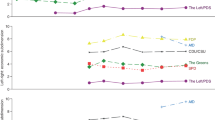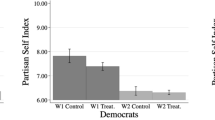Abstract
In a seminal paper on electoral equilibrium under majority rule, Ledyard (1984) demonstrates that strategic participation by voters results in an electoral equilibrium at the proposal that maximizes the utility of a randomly selected voter. Palfrey and Rosenthal (1985) limit the usefulness of this result by showing that strategic participation rates are miniscule in large electorates, and that the incentive to participate vanishes completely as the electorate grows without bound. The most reasonable modification of Ledyard’s approach that circumvents these criticisms is to allow for a negative cost of voting. We show that when voters can have even an arbitrarily small negative cost of voting, there is an electorate sufficiently large so that any proposal is defeated or tied by the median proposal. This observation raises questions about the existence of electoral equilibrium under strategic participation, and is relevant to the efficiency of elections.
Similar content being viewed by others
References
Coughlin, P. and S. Nitzan, 1981, Directional and local electoral equilibria with probabilistic voting, Journal of Economic Theory 24, 226–239.
Hinich, M., 1977, Equilibrium in spatial voting: The median voter result is an artifact, Journal of Economic Theory 16, 208–219.
Kramer, G., 1978, Robustness of the median voter result, Journal of Economic Theory 19, 565–567.
Kramer, G., 1973, On a class of equilrium conditions for majority rule, Econometrica 41, 285–297.
Ledyard, J., 1984, The pure theory of large two-candidate elections, Public Choice 44, 7–41.
McKelvey, R., 1976, Intransitivities in multidimensional voting models and some implications for agenda control, Journal of Economic Theory 12, 472–482.
Marsden, J., 1974, Elementary classical analysis.
Palfrey, T. and H. Rosenthal, 1985, Voter participation and strategic uncertainty, American Political Science Review 79, 62–78.
Plott, C., 1967, A notion of equilibrium and its possibility under majority rule, American Economic Review 57, 787–806.
Riker, W. and P. Ordeshook, 1968, A theory of the calculus of voting, American Political Science Review 62, 28–42.
Rubinstein, A., 1979, A note about the ‘nowhere-denseness’ of societies having an equilibrium under majority rule, Econometrica 47, 511–514.
Sunding, D., 1995, Strategic participation and the median voter result, Social Choice and Welfare 12, 3–12.
Author information
Authors and Affiliations
Rights and permissions
About this article
Cite this article
Sunding, D. Strategic participation and the median voter result. Economic Design 1, 355–363 (1994). https://doi.org/10.1007/BF02716632
Issue Date:
DOI: https://doi.org/10.1007/BF02716632




